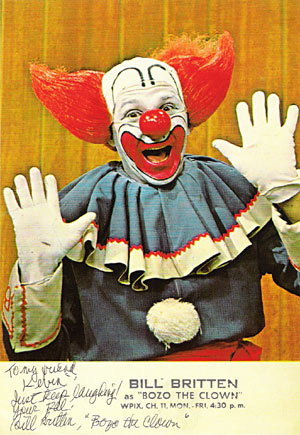There probably isn’t an adult in the US today who hasn’t watched some version of Bozo the Clown when they were growing up. In one form or another, Bozo was one of the longest-running kids’ shows in TV history. The earliest version of the Bozo show began airing in 1949 in Los Angeles, and the show continued to air around the country until 2001. Like Romper Room before it, Bozo’s show was both syndicated and franchised, which means that many local TV stations produced their own version of the show. Each show was hosted by an actor made up as Bozo the Clown, a circus clown with typical white-face make-up, red clown nose, and brightly-colored clown suit with a large frilly collar. What made Bozo special was his hair – a huge bright red-orange mass that stuck out and up about a foot from the sides of his white bald head.
Like many children’s shows in the early days of TV, the show at first had a fairly simple format in which the host just introduced and transitioned among a series of cartoon segments, including a cartoon that featured an animated Bozo. Later, the Bozo the Clown show (sometimes called Bozo’s Circus or Bozo’s Big Top) took on more of a circus or vaudeville format, with many of the local shows seeming to take place inside a circus tent, with a live studio audience of children (sometimes mixed with parents), and offering a variety of circus acts, comedy routines, cartoons, and segments that featured other recurring characters and often local children engaging in games and contests.
The most successful and probably best-known local version of the Bozo franchise was the show produced in Chicago by WGN-TV, which featured Bob Bell as Bozo. It evolved into Bozo’s Circus, a live hour-long show with a 13-piece orchestra, 200-member live studio audience, and multiple cast of characters, including Ringmaster Ned, Oliver O. Oliver, Sandy the Clown, Mr. Bob the Bandleader, and Cooky the Cook . At one point, there was a ten-year wait for tickets to be part of the show’s studio audience. The Chicago show was also syndicated to stations around the country which didn’t or couldn’t produce their own version of the show.
The Boston version of the Bozo the Clown show was also very popular locally and syndicated nationwide for several years. Hosted by Bob Avruch as Bozo, the show at one time featured actor/puppeteer Caroll Spinney as “Mr. Lion” and “Kookie the Boxing Kangaroo.” Spinney later went on to portray Big Bird and Oscar the Grouch on Sesame Street.
In New York, WPIX was the first station to produce a local version of the Bozo the Clown show in 1959, starring Bill Britten as Bozo. In 1964, WOR created and produced its own Bozo Show, featuring singer/actor Gordon Ramsey as Bozo, together with a cast of characters that included Grandma Nelly, Professor Tweetiefoofer, Slimjim, Snappy Pappy, and the Circus Boss.
Before he became the TODAY Show’s weatherman, Willard Scott starred as Bozo in the Washington D.C. version of the Bozo show. Scott went on to portray the Bozo-inspired “Ronald McDonald” clown character in McDonald’s commercials.
Over the years, stories have circulated about children on the Bozo show who used profanity or said something nasty to Bozo on the air, or about Bozo himself saying something nasty back to one of the kids when he didn’t think the microphone was on. Though it’s clear that Bozo was the inspiration for the curmudgeonly Krusty the Klown character on the Simpsons, I guess we’ll never know if any of these stories about bad behavior on the Bozo show are actually true.
You can watch Bozo the Clown in several DVD collections: Bozo: The World’s Most Famous Clown, Vol. 1 and Vol.2, Volume 1 – Best of Bozo, Larry Harmon’s Bozo: Shows 4-6, or Hiya Kids! A 50’s Saturday Morning Box.


Recent Comments